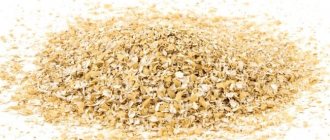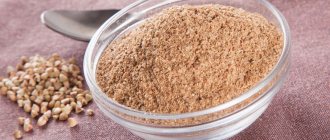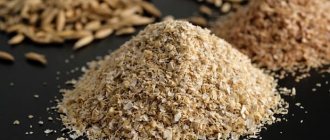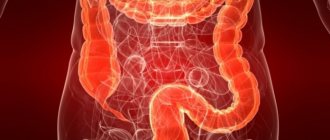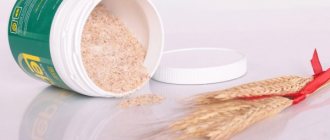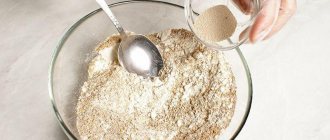Bran or fiber, which is better? Very often people ask this question, especially when it comes to weight loss issues. But it is also important for any person who strives to get the right diet and feel great. Vital tone and the presence of diseases depend on this. Let's compare these two products: bran, fiber.
Bran is the product remaining after grinding grain into flour, in simple terms - the husk or ground fruit shell of the grain. We wrote about this in a previous article: “Bran and flakes. Key Differences" comparing these products.
Fiber is dietary fiber found in the very structural tissue of a plant. It is not digested by the body, but at the same time it brings undoubted benefits to the microflora of the stomach.
Fiber and bran: are they the same thing or not?
Those who try to lead a healthy lifestyle and eat right know how important dietary fiber is for the body. Their main sources, fiber and bran, are considered by many to be one and the same product.
But this opinion is wrong. Both ingredients are extracted from plants and provide similar benefits to the body, but there are differences between them. Fiber is just one of the components of bran.
What is fiber
Cellulose is a polysaccharide. In its purified form, it is a carbohydrate without any foreign impurities. However, in practice it is not so highly refined, so it contains other compounds (proteins, fatty acids) in small quantities.
The substance is included in the group of dietary fibers, since a significant part of it is not absorbed by the body. Only a small proportion of cellulose derivatives (soluble fiber) is broken down.
The main benefits of dietary fiber:
- activation of intestinal function;
- cleansing the body of waste and toxins;
- reducing the feeling of hunger due to swelling in the stomach.
These substances are found in all plants in varying quantities. Cereals and legumes, vegetables, herbs, fruits are rich in them, and they are also found in nuts.
Is there a catch?
There is no doubt that there are pitfalls in consuming these two miracle products, or “superfoods”, as they say in certain circles. They can bring not only benefits to the body, but also harm, especially if consumed in excess .
First of all, it is worth mentioning the dangers of fiber and, of course, bran, partly consisting of it, for people with exacerbations of peptic ulcers, gastritis, colitis, enteritis and diarrhea. Also, if there are adhesions in the abdominal cavity, consuming fiber can lead to significant complications.
At the stages of exacerbation of such diseases, the consumption of foods containing dietary fiber is strictly not recommended. After the exacerbation stage has subsided, it is introduced into food with caution and gradually , and with prior agreement with the attending physician.
Eating large amounts of bran can also interfere with the body's absorption of some important vitamins and minerals, so before planning a diet based on bran or large amounts, it is also better to consult a doctor and undergo the necessary tests . This will help avoid unpleasant consequences.
What is the difference between fiber and bran?
Many plants can be a source of fiber; it is included in a large list of products, including as a thickener, and is sold as a dietary supplement and for weight loss.
Bran is made from grain, it is sold in its pure form or enriched baked goods and cereals. They are not found in other foods.
Well-purified cellulose will have an energy value of about 40 kcal per 100g. But supplements with a calorie content of 150-170 kcal are more often found on sale.
Crushed shells with germ are a complex of compounds; they always contain protein and fats in varying quantities, which depends on the raw material. Therefore, their calorie content per 100 g is higher and is approximately 250 kcal for wheat and 350 kcal for oatmeal.
This is a more nutritious and valuable component. The “waste” from flour production includes up to 80% fiber, so to achieve an effect on dietary fiber, you need to eat more of it.
The main common property of these food additives is that they swell in water, increase in size and create a feeling of fullness. In addition, as sorbents, they remove cholesterol and many harmful substances from the body. But bran is also a supplier of nutrients.
What is the difference
Fiber is a general term meaning plant fibers that are found in plant foods, including bran. It is not absorbed by the body, but passing through the digestive system, cleanses it and removes harmful substances from it. Bran is 80% fiber. It is a by-product of the production of flour from various grains. The remaining solid parts of the grain contain microelements and vitamins beneficial to the body. When used correctly, they help prevent various diseases and remove excess weight.
Food and drinksComment
Which bran has the most fiber?

The cellulose content in grain shells varies greatly depending on the raw materials from which they are obtained and ranges from 15 to 80%. Wheat ones are optimal for several reasons.
This is the most common option. They have a rich composition, include many B vitamins, and are easy to digest.
The record holders for carbohydrate content are the by-products of corn processing, but you shouldn’t buy flax for these substances: they simply aren’t there.
How much fiber is in bran by type is presented in the table:
| Variety of grain hulls | Dietary fiber, g per 100 g | Dietary fiber in 1 tablespoon (15 g) |
| Corn | 80 | 12 |
| Rye | 45 | 6,8 |
| Wheat | 43-45 | 6,5-6,8 |
| Rice | 20 | 3 |
| Oatmeal | 15 | 2,3 |
| Linen | Do not contain | Do not contain |
1 tablespoon contains approximately 15 g of bran. The exact weight depends on their degree of grinding (12 g for coarse and up to 20 g for fine).
Nutritional features and diet menu for the week
For high-quality weight loss and normalization of stomach function, you should practice the diet for 1-2 weeks. Recipes can be combined if desired, but the main thing is to constantly use bran in cooking.
Example diet for 1 week:
- Breakfast - porridge of oatmeal or grains with 1 tbsp. a spoonful of bran and a spoonful of sunflower oil.
- Snack after 3 hours – fresh vegetables, fruits, optionally dried fruits.
- Lunch – vegetable soup, meat without fat (or low-fat fish).
- Dinner – a handful of raisins, 1 glass of kefir mixed with 1 tablespoon of bran.
Diet for week 2:
- Breakfast - porridge. To prepare it, boil 1 tbsp. spoon of bran for 30 minutes in 400 ml of water (do not add salt or oil).
- Snack after 3 hours - cottage cheese (100 g), prunes (200 g), berries.
- Lunch – baked potatoes, vegetable salad.
- Afternoon snack – yogurt (100 g) with an apple or pear as a bite.
- Dinner – vegetable salad (200 g), 2 slices of whole grain bread, 100 g of tofu or 1 glass of soy milk.
Example diet for week 3:
- Day 1 – unloading. Throughout the day, they take a special bran porridge and drink 1.5 liters of kefir with prebiotics. You can mix porridge and kefir, take the mixture as hunger sets in.
- 2nd day - completely repeat the diet established in the 2nd week.
- Day 3 – fasting. They eat bran porridge again, but now add 1.5 kg of baked apples to it. Take during the day in modest portions.
The following days correspond to the diet of the 2nd week.
After finishing this diet, cleansing should be completed correctly in order to switch to a normal regime. It is better to include fresh vegetables in the menu; it is worth eating whole bran for about another week in addition to regular food.
Which is healthier?
It all depends on what goals a person pursues:
- If you need to saturate your body with nutritional components, then it is definitely better to purchase bran. With a stable weight, they can be included in baked goods, added to porridge, and prepared in cocktails. From a nutritional point of view, this product is much healthier.
- If the main goal is cleansing the intestines and losing weight, then you should give preference to fiber. It is lower in calories and needs to be eaten in smaller quantities.
You can first practice a diet using cellulose, and after getting rid of extra pounds, switch to eating crushed shells.
How often is colon cleansing done?
It is important not to abuse this product, because bran is not a panacea for all ills, for fat deposits. You can eat as usual, but it is better not to eat harmful foods - this will minimize the benefits.. But you should not radically change your diet.
It is definitely important to increase the amount of fiber, because if there is a deficiency, taking bran suddenly and without preparation is fraught with consequences. It is worth introducing them into the diet gradually. For about 3 weeks, eat raw vegetables, fresh fruits, take them in the morning. To avoid disturbances, it is worth reducing the amount of food that contains a lot of plant fiber - in combination with bran this will have a negative effect.
Important: follow the drinking norm, drink 1.5 - 2 liters of clean water a day, use juices and decoctions.
Cleansing with bran can be done once a season, if the body is highly polluted and there is a need to lose weight. They are used in alternative medicine, in Russian cuisine and as a component of various decoctions and potions. In the old days, they were used to heal constipation and other gastrointestinal disorders, and were used as a food supplement, especially during crop failure.
What's best for losing weight?
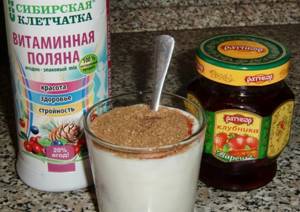
To lose weight, you should choose pure fiber. It should be introduced into the diet in small portions, constantly increasing the amount to 25 g per day.
There is no need to chew it dry. The substance is mixed with water, kefir or juices. It can be added to soups and porridges.
Read more about how to take fiber for weight loss by following the link.
Fiber for weight loss - reviews from doctors
Doctors have very mixed opinions about this method of losing weight. Some believe that by taking fiber in recommended doses, you can lose weight and improve your health. Others note that this method is not only ineffective, but even harmful to health, since incorrect intake, and in fact, even recommended doses can be perceived differently by the body in individual cases, can lead to various problems with the gastrointestinal tract.
In any case, if you decide to try such nutritional supplements on yourself, start with the most minimal doses and listen to your body, immediately refusing to take them if you have various ailments, or even better, consult your doctor.
How to take bran
Due to the presence of coarse fibers, grain shells stimulate the intestines, they act as food for beneficial bacteria, and therefore help with constipation. They are consumed no more than 2 tablespoons per day, but you should start with 1 teaspoon.
To facilitate bowel movements, it is useful to drink bran diluted in a glass of kefir or yogurt.
During administration, it is important to maintain a drinking regime and consume at least 2 liters of water.
For other ways to take bran and what you can cook with it, read the link.
The best bran for colon cleansing
Different manufacturers offer a large selection of product brands. When choosing, it is important to take into account the composition and other characteristics:
- initial set of components;
- calorie content;
- origin - from oats, rice, wheat, rye, corn, flax.
Let's consider the features of each type of bran from the point of view of effectiveness and benefit. For those who require soluble fiber, it is better to consume wheat, rice or oat fiber. Rye and corn are in the insoluble category. The first option is suitable for gentle cleansing, for a long-term diet, the second - for quickly emptying the intestines in case of constipation, problems with stool, which promotes rapid bowel movements.
The calorie content of bran is not so low, but due to the fact that it is impossible to eat a lot of it, this factor should not worry you - the benefits from the product are much greater. Eg:
- in oatmeal – 319 kcal per 100 g,
- wheat – 179 kcal,
- rye – 220 kcal.
According to nutritionists, the most universal option is oat and wheat. Whole ones are more beneficial, but you can also use ground and powdered ones, as well as airy bran sticks.
This is a really cheap way to clean. Wheat bran is sold at a price of 10-15 rubles per 150 grams. One package is enough for a cleaning course.
Is it possible to replace bran with fiber?
There will be no harm to the body if you eat cellulose instead of grain shells. But this is not a full-fledged replacement; it can only be practiced on fasting days.
If we are talking about a long-term diet, then such a substitution cannot be carried out. After all, these products have completely different chemical compositions, and their main difference is their energy value. If you replace it 1:1, then the body will not receive the required amount of calories.
In addition, individual nutrition systems specify not just grain shells, but a specific product. For example, the Dukan diet insists on oat bran.

The most useful foods in the fight against obesity and diabetes
Plant fibers, contained in large quantities in oat bran, are poorly processed in the stomach, and thanks to this, a person does not feel hungry for a longer time. Also, fiber from oat bran has a low calorie content.
As it passes through the intestines, fiber swells, creating a soft mass that cleanses the intestines of waste products and carcinogens. Due to this, oat bran fiber has the ability to reduce glucose and cholesterol levels in the blood.
Fiber from oat bran is recommended for patients with diabetes as an effective additional method. Systematic consumption of it in food restores metabolism and reduces blood sugar levels.
It also slows down the absorption of carbohydrates, thereby inhibiting the increase in blood glucose levels, which will allow patients with diabetes to significantly reduce the use of insulin-containing drugs.
The fiber in oat bran slows down the processing of food products, and therefore, spikes in blood sugar levels are slowed down and reduced to a minimum, and the work of the pancreas is also facilitated. Accordingly, the need for insulin and other antidiabetic drugs is reduced.

